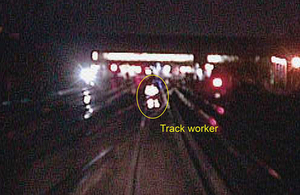Report 12/2019: Near miss with a track worker near Gatwick Airport station
RAIB has today released its report into a near miss with a track worker near Gatwick Airport station on 2 December 2018.

Night time image from forward facing CCTV camera on approaching train showing a trackworker moving across the lines (courtesy of Govia Thameslink Railway)
Summary
At 23:24 hrs on 2 December 2018, a track worker narrowly avoided being struck by a train between Horley and Gatwick Airport stations, on the boundary between Surrey and West Sussex. The track worker, a controller of site safety (COSS), was undertaking work related to the electrical isolation of conductor rails and moved out of the path of the train just before it reached him.
CCTV Footage of the near miss at Gatwick Airport station (courtesy of Govia Thameslink Railway)
The Network Rail isolation planning process meant that BAM Nuttall planners lacked the information needed for them to establish the exact location at which work was to be carried out on the track. The planners lacked the skills and experience needed to understand this and so provided a system of work which provided no protection from train movements at the actual location of the task. The COSS recognised that the planned system of work lacked adequate protection from train movements, but undertook the task without implementing an alternative safe system of work. A second track worker involved in the isolation task did not challenge the COSS about the unsafe method of working. The underlying factor was that Network Rail isolation processes did not provide planners outside Network Rail with sufficient information to always be able to plan safe systems of work.
Recommendations
The RAIB has recommended that Network Rail should improve its isolation planning processes so that safe system of work planners receive the information they need to plan all associated work safely. The RAIB has also recommended that BAM Nuttall should improve its safe system of work planning process to ensure that its planners do not plan work without sufficient information to identify appropriate protection measures.
The RAIB has also identified four learning points relating to working in accordance with appropriate safe systems of work, challenging unsafe work practices, planners seeking additional information when needed to plan safe systems of work and use of train horns.
Simon French, Chief Inspector of Rail Accidents said:
Once again the RAIB has to report on an alarming near-miss between a train and a track worker. We have seen far too many of these incidents in recent years, and the recent tragic accidents at Stoats Nest Junction, just a few miles from Gatwick, and at Margam, which is still under investigation, are a stark reminder of how terrible the consequences of mixing trains and people can be.
When engineering work takes place on and around lines electrified on the conductor rail system, it is important that the conductor rails are isolated and earthed, to protect everyone from electrical hazards. Straps between the conductor rail and the running rail are the usual means of achieving this, although it’s good to see that remote isolation devices are now being introduced at some locations. Placing and removing these straps is an important task, which can expose people to great risk if it is not planned and carried out to a high standard. In this case the plan called for some straps to be fitted on tracks outside the area protected by the possession arrangements, even though there was an alternative site available, where the straps could have been placed within the possession. The information about the alternative site was not available to the planners who needed it, and they did not identify the need for additional protection from trains when the straps were to be applied. We are recommending that Network Rail improves its processes so that all planners get the right information at the right time.
The staff who were given the defective plans did not challenge them. Having managed to place the straps without incident, they went out to remove them the next day, knowing that the straps were attached to lines outside the possession, but believing that no trains would pass by while they were doing their work. It was considered OK to take a risk to get the job done, and no-one felt able to challenge this.
We have previously recommended, in two recent reports, that Network Rail should improve the leadership skills of team leaders and supervisors. Work is being done to address this, but railway industry staff at all levels must understand the importance of good leadership: getting people to do the right thing, at the right time, all the time.
Notes to editors
- The sole purpose of RAIB investigations is to prevent future accidents and incidents and improve railway safety. RAIB does not establish blame, liability or carry out prosecutions.
- RAIB operates, as far as possible, in an open and transparent manner. While our investigations are completely independent of the railway industry, we do maintain close liaison with railway companies and if we discover matters that may affect the safety of the railway, we make sure that information about them is circulated to the right people as soon as possible, and certainly long before publication of our final report.
- For media enquiries, please call 01932 440015.